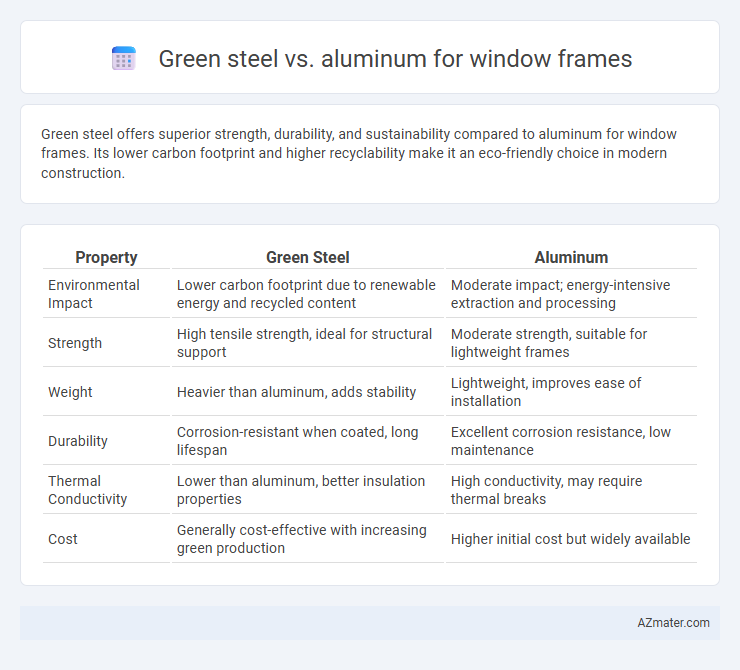Green steel offers superior strength, durability, and sustainability compared to aluminum for window frames. Its lower carbon footprint and higher recyclability make it an eco-friendly choice in modern construction.
Table of Comparison
| Property | Green Steel | Aluminum |
|---|---|---|
| Environmental Impact | Lower carbon footprint due to renewable energy and recycled content | Moderate impact; energy-intensive extraction and processing |
| Strength | High tensile strength, ideal for structural support | Moderate strength, suitable for lightweight frames |
| Weight | Heavier than aluminum, adds stability | Lightweight, improves ease of installation |
| Durability | Corrosion-resistant when coated, long lifespan | Excellent corrosion resistance, low maintenance |
| Thermal Conductivity | Lower than aluminum, better insulation properties | High conductivity, may require thermal breaks |
| Cost | Generally cost-effective with increasing green production | Higher initial cost but widely available |
Introduction to Green Steel and Aluminum in Window Frames
Green steel, produced using sustainable methods that reduce carbon emissions, offers a durable and eco-friendly alternative for window frames, enhancing energy efficiency and structural strength. Aluminum, widely recognized for its lightweight properties and corrosion resistance, remains a popular choice in window frames due to ease of manufacturing and recyclability. Both materials contribute to sustainable building practices, but green steel's environmental benefits make it increasingly attractive in modern construction.
Environmental Impact: Green Steel vs Aluminum
Green steel production significantly reduces carbon emissions by utilizing hydrogen or renewable energy sources, offering a lower environmental impact compared to traditional steel. Aluminum manufacturing is energy-intensive, emitting substantial greenhouse gases and contributing to higher environmental costs despite its recyclability. Lifecycle assessments reveal green steel frames have a smaller carbon footprint, making them a more sustainable choice for eco-friendly window construction.
Energy Consumption in Material Production
Green steel production consumes significantly less energy compared to traditional steel, reducing carbon emissions in window frame manufacturing. Aluminum requires approximately 10-15 times more energy in its production process, leading to higher embodied energy in aluminum window frames. Selecting green steel for window frames minimizes energy consumption and supports sustainable building practices.
Durability and Longevity Comparison
Green steel window frames offer superior durability and longevity compared to aluminum, with higher resistance to corrosion, dents, and warping under extreme weather conditions. Steel's tensile strength ensures structural integrity over decades, often outperforming aluminum which can degrade faster due to oxidation and surface wear. The environmental benefits of green steel, combined with its enhanced lifespan, make it a preferred choice for sustainable and long-lasting window framing solutions.
Thermal Performance and Insulation Properties
Green steel window frames offer superior thermal performance due to their high strength-to-weight ratio combined with advanced thermal break technology, reducing heat transfer significantly. Aluminum frames provide moderate insulation but often require thermal breaks to meet energy efficiency standards, as aluminum is a highly conductive material. Green steel outperforms aluminum in maintaining consistent indoor temperatures, enhancing energy savings through better thermal resistance and lower thermal bridging.
Cost Analysis: Green Steel vs Aluminum
Green steel window frames typically incur higher upfront costs than aluminum due to advanced production methods and sustainability premiums. Aluminum offers lower initial expenses and is widely available, but may lead to increased lifecycle costs from energy consumption and environmental impact. Evaluating total cost of ownership, including installation, maintenance, and environmental benefits, reveals green steel as a competitive option for long-term, eco-conscious projects.
Aesthetic Versatility and Design Options
Green steel offers superior aesthetic versatility and design options for window frames due to its strength, allowing for slimmer profiles and larger glass expanses that create modern, sleek looks. Aluminum also provides excellent design flexibility with its lightweight nature and ability to be powder-coated in various colors, but it often lacks the robustness of green steel for high-performance applications. The choice between green steel and aluminum depends on desired style, durability, and environmental sustainability goals.
Recycling and End-of-Life Considerations
Green steel for window frames offers superior recyclability with a recycling rate exceeding 90%, enabling multiple reuse cycles without significant loss of strength, which reduces environmental impact over its lifecycle. Aluminum also provides excellent recyclability, with about 75% of all aluminum ever produced still in use due to energy-efficient recycling processes that save up to 95% of the energy compared to primary production. End-of-life considerations favor green steel when structural durability and mechanical strength are critical, while aluminum's lightweight properties benefit applications where ease of handling and corrosion resistance are prioritized.
Installation and Maintenance Requirements
Green steel window frames offer easier installation due to their higher strength-to-weight ratio, allowing for slimmer profiles and reduced structural support compared to aluminum. Maintenance for green steel involves regular inspection for corrosion and application of protective coatings, whereas aluminum requires less frequent upkeep but can suffer from surface oxidation and denting. Both materials demand careful sealing to prevent air and water infiltration, but green steel's durability typically translates to lower long-term maintenance costs.
Future Trends in Sustainable Window Frame Materials
Green steel and aluminum both lead the future of sustainable window frame materials by balancing durability and eco-friendliness. Green steel, produced using hydrogen-based reduction processes, significantly lowers carbon emissions compared to traditional steel, aligning with global decarbonization goals. Aluminum remains valuable due to its recyclability and lightweight properties, with innovations targeting improved energy efficiency and reduced embodied carbon in its production.

Infographic: Green steel vs Aluminum for Window frame
 azmater.com
azmater.com